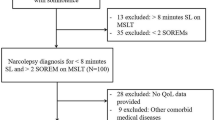Abstract
Objective
The Minnesota Multiphasic Personality Inventory (MMPI) responses between snorers and obstructive sleep apnea (OSA) may be different. Thus, we compared the MMPI responses between snorers and OSA.
Design
A clinical-based cross-sectional survey.
Participants
This is a survey of 94 treatment-naive sleep-disordered breathing (SDB) subjects.
Method
Clinical information, body mass index (BMI), 36-item Short Form Health Survey, the Turkish version of the MMPI, Epworth sleepiness scale (ESS), fatigue scale, attention-deficit scale, and polysomnography were collected. All patients with OSA and snorers was accepted as individuals with SDB (AHI > 0 events/h). The threshold of five apnea and hypopnea per hour of sleep was chosen to define both OSA and snorers. Disability profile is consisting of four or more MMPI clinical scale elevations.
Results
OSA patients compared to snorers have significantly higher absolute scores on hypochondriasis (Hs) (65.0 ± 12.0 vs 58.4 ± 7.9, p = 0.01, respectively). OSA patients compared to snorers have significantly higher rate of clinical elevation on both psychopathic deviance (13.0 vs 0 %, p = 0.03, respectively) and Hs (26.1 vs 3.3 %, p = 0.01, respectively).
People with disability profile has lower the quality of life, a higher score for inattention, a higher fatigue scores, and higher sleepiness scores. The quality of life and attention deficit and daytime sleepiness scores were associated with total MMPI absolute score in individuals with SDB in bivariate analyses.
Conclusion
Present study indicated that patients with OSAS compared to snorers displayed significantly more hyopchondriasis and psychopathic deviance personality characteristics. The daytime functions in individuals with sleep-disordered breathing may be influenced by the severity of psychopathology.
Similar content being viewed by others
References
Vgontzas AN, Kales A (1999) Sleep and its disorders. Annu Rev Med 50:387–400
Haba-Rubio J (2005) Psychiatric aspects of organic sleep disorders. Dialogues Clin Neurosci 7(4):335–346
Sateia MJ (2009) Update on sleep and psychiatric disorders. Chest 135(5):1370–1379
Moran AM, Everhart DE, Davis CE, Wuensch KL, Lee DO, Demaree HA (2011) Personality correlates of adherence with continuous positive airway pressure (CPAP). Sleep Breath 15(4):687–694
Yu BH, Ancoli-Israel S, Dimsdale JE (1999) Effect of CPAP treatment on mood states in patients with sleep apnea. J Psychiatr Res 33(5):427–432
Pillar G, Lavie P (1998) Psychiatric symptoms in sleep apnea syndrome: effects of gender and respiratory disturbance index. Chest 114(3):697–703
Day R, Gerhardstein R, Lumley A, Roth T, Rosenthal L (1999) The behavioral morbidity of obstructive sleep apnea. Prog Cardiovasc Dis 41(5):341–354
Sateia MJ (2003) Neuropsychological impairment and quality of life in obstructive sleep apnea. Clin Chest Med 24(2):249–259
Rechtschaffen A, Kales A (1968) A manual of standardized terminology, techniques, and scoring system for sleep stages of human subjects. U.S. Government Printing Office, Bethesda
Savaşır I (1981) Minesota Çok Yönlü Kişilik Envanteri-Elkitabı (TürkStandardizasyonu). Sevinç Matbaası, Ankara
Erol N (1982) Ülkemizde psikiyatrik hastalarda Minnesota Çok Yönlü Kişilik Envanterinin geçerlik araştırması. Doktora Tezi. AÜ. DTCF Psikoloji Kürsüsü
Hui DS, Chan JK, Ho AS, Choy DK, Lai CK, Leung RC (1999) Prevalence of snoring and sleep-disordered breathing in a student population. Chest 116:1530–1536
Turgay A (1995) DSM-IV’e dayalı erişkin dikkat eksikliği hiperaktivite bozukluğu tanı ve değerlendirme envanteri (yayınlanmamış ölçek) integratif terapi enstitüsü, Kanada
Günay Ş, Savran C, Aksoy UM, Maner F, Turgay A, Yargıç İ (2006) Erişkin Dikkat Eksikliği Hiperaktivite ölçeğinin (Adult ADD/ADHD DSM IV based diagnostic screening and rating Scale) dilseleşdeğerlilik, geçerlik güvenirlik ve norm çalışması. Türkiye’de Psikiyatri 8:98–107
Johns MW (1991) A new method for measuring daytime sleepiness: the Epworth sleepiness scale. Sleep 14(6):540–545
Ağargün MY, Çilli AS, Kara H, Bilici M, Elcioğlu MT, Semiz ÜB, Başoğlu C (1999) Epwort Uykululuk Ölçeği’nin Geçerliği Ve Güvenirliği. Türk Psikiyatri Dergisi 10(4):261–267
Ware JE, Sherbourne CD (1992) The MOS 36-Item Short-Form Survey (SF-36). I. Conceptual framework and item selection. Med Care 30:473–483
Koçyiğit H, Aydemir Ö, Fişek G (1999) Kısa Form-36’nın (KF-36) Türkçe için güvenilirliği ve geçerliliği. Romatizmal hastalığı olan bir grup hasta ile çalışma. İlaç ve Tedavi Dergisi 12:102–106
Kidner CL, Gatchel RJ, Mayer TG (2010) MMPI disability profile is associated with degree of opioid use in chronic work-related musculoskeletal disorders. Clin J Pain 26(1):9–15
Singer HK, Ruchinskas RA, Riley KC, Broshek DK, Barth JT (2001) The psychological impact of end-stage lung disease. Chest 120(4):1246–1252
Aikens JE, Mendelson WB (1999) A matched comparison of MMPI responses in patients with primary snoring or obstructive sleep apnea. Sleep 22(3):355–359, 1
Aikens JE, Caruana-Montaldo B, Vanable PA, Tadimeti L, Mendelson WB (1999) MMPI correlates of sleep and respiratory disturbance in obstructive sleep apnea. Sleep 22(3):362–369, 1
Kales A, Caldwell AB, Cadieux RJ, Vela-Bueno A, Ruch LG, Mayes SD (1985) Severe obstructive sleep apnea–II: associated psychopathology and psychosocial consequences. J Chronic Dis 38(5):427–434
Beutler LE, Ware JC, Karacan I, Thornby JI (1981) Differentiating psychological characteristics of patients with sleep apnea and narcolepsy. Sleep 4(1):39–47
Ramos Platón MJ, Espinar Sierra J (1992) Changes in psychopathological symptoms in sleep apnea patients after treatment with nasal continuous positive airway pressure. Int J Neurosci 62(3–4):173–195
Edinger JD, Carwile S, Miller P, Hope V, Mayti C (1994) Psychological status, syndromatic measures, and compliance with nasal CPAP therapy for sleep apnea. Percept Mot Skills 78(3 Pt 2):1116–1118
Hayashida K, Inoue Y, Chiba S, Yagi T, Urashima M, Honda Y, Itoh H (2007) Factors influencing subjective sleepiness in patients with obstructive sleep apnea syndrome. Psychiatry Clin Neurosci 61(5):558–563
Akashiba T, Kawahara S, Akahoshi T, Omori C, Saito O, Majima T, Horie T (2002) Relationship between quality of life and mood or depression in patients with severe obstructive sleep apnea syndrome. Chest 122(3):861–865
Author information
Authors and Affiliations
Corresponding author
Rights and permissions
About this article
Cite this article
Ekici, A., Ekici, M., Oğuztürk, Ö. et al. Personality profiles in patients with obstructive sleep apnea. Sleep Breath 17, 305–310 (2013). https://doi.org/10.1007/s11325-012-0691-5
Received:
Revised:
Accepted:
Published:
Issue Date:
DOI: https://doi.org/10.1007/s11325-012-0691-5



